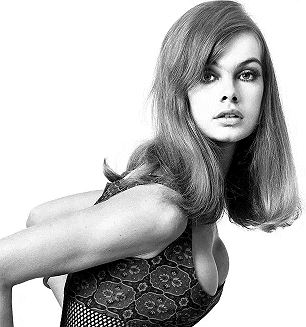Sixties
City presents
a wide-ranging series of
articles on all aspects of the Sixties, penned by the creator of the iconic
60s music paper Mersey
Beat
|
Sixties
City presents
a wide-ranging series of
articles on all aspects of the Sixties, penned by the creator of the iconic
60s music paper Mersey
Beat
|
|||||
|
The fashion company Orlon, who hired her, didn’t brief her on the assignment. They also sent her some inexpensive dress and suit lengths, rather than ready-made outfits. Jean was left to design what she wanted and had them made up. She hired a dressmaker, Colin Rolf, who discovered there was not sufficient fabric for her designs. He then said, “Oh, it doesn’t matter. Make them a bit shorter – no one’s going to notice". “And that’s how the mini was born,” says the Shrimp. She settled for four outfits, all above the knee. On the day of the race she didn’t bother wearing any stockings, her dress was short, she had no hat or gloves – and the organisers were cross. |
 |
 |
The Melbourne Cup was the smartest event in the Australian year; the conservatively
dressed members of Australian society who attended were shocked at her appearance,
which they considered insulting and disgraceful. She
was surrounded by photographers shooting upwards to make her skirt look
even shorter. She became a cause celebre and subsequently appeared on the
front pages of newspapers throughout the world. It created a huge controversy
in Australia, half the country for her and half against – with the young
people loving it. All over Australia girls started shortening their skirts. The pictures, which the British newspaper had used, had the same results back home. Suddenly the mini, which had only had a half-hearted start in Paris, became fashionable. “Mary Quant rode in on the back of it, immediately making shorter skirts. Many people gave her credit for the new craze, but the truth was that the mini took off because Orlon had been stingy with the fabric”. In 1967, while in New York, she began an affair with photographer Jordan Kalfus, who’d previously lived with Ali McGraw, a model who had begun a new career as a film star. The two lived together for two years, but Jean pined for London. She ended the affair in 1969. She was now 26 years old and had been modelling for eight years. The new man in her life was Heathcote Williams, an anarchic and virtually penniless writer for the Transatlantic Revue. Their relationship proved to be a volatile one. Jean bought a house in Darnley Terrace, Holland Park, in which there was a study for Williams to work in. However, he kept a virtual open house. She was to comment that he invited many of the people he was working with to stay; “but they did not contribute to the household expenses, not even towards the telephone calls they made. I suppose they couldn’t. I was the only one with any money. I did not take too much notice at first, but when the money began to run out and I was forced to look for work, I began to think differently”. The two argued and split up. Malcolm, a friend of Williams, arrived on her doorstep one day. She told him that Heathcote didn’t live there any more, but invited him to stay. They became lovers and the affair lasted for seven years. They decided to visit Cornwall where Malcolm had studied at Falmouth Art School. He also had a Cornish wife and a girlfriend who’d had his baby, before leaving him. They initially rented a cottage near Penzance, and then moved on to Wales for a time. The Shrimp's money was shrinking fast, particularly since she had Malcolm’s wife, girlfriend and two children to consider. After two years in Wales they moved back to London, sold the big house in Holland Park and bought a smaller property near Ladbroke Grove. Malcolm became homesick for Cornwall and, because Jean had come to like Cornwall so much, they decided to go and live there. |
 |
 |
A friend suggested she open an antiques shop. One of her customers was a
tall, handsome blond man, Michael Cox. When Malcolm had become involved
with a group of Buddhists who had decided to move on to Cambridgeshire,
he opted to go with them. Jean stayed behind in Cornwall and her affair
with Michael began. He was to divorce his wife Caroline and the couple were married at Penzance register office in January 1979. Jean was three months pregnant at the time. They held their wedding reception at the Abbey Hotel, an old Gothic-fronted house that overlooked the harbour. Her pregnancy was a difficult one because she has a condition called hyperemesis-gravidarum, which causes acute dehydration. Soon after their son Thaddeus was born, they heard that the Abbey Hotel was up for sale and decided to buy it. That is where Jean, Michael and Thaddeus live today and Jean is happier than she’s ever been. She was never comfortable with the trappings of success – when David Bailey used to take her to trendy nightclubs, she’d take her knitting with her! – and loved running her hotel. The Abbey Hotel is an enchanting place – and there is not one picture of ‘The Shrimp’ as a model to be found anywhere on the premises!
|
 |
|
Article
Text
UK
web hosting by
|